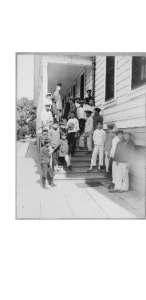Lithographs of the Gold Rush in California (1850)

Digital Public Library of America
This lithograph of Coloma, California was created in 1850 as part of the Frank Christy collection. The drawing was used as the cover of a London newspaper in 1850, two years after the beginning of the California Gold Rush. The lithograph was used a way to inform the world about the major, literal, gold mine in America and how many people were immigrating there in order to prosper from the precious metal. The majority of immigrants came from China as America was being advertised as a country with “streets paved with gold” and China was experiencing a major crop failure, causing them to turn to new sources of income. This is significant because it explains what caused such a high Chinese population in California which then led to the Chinese Exclusion Act.
Chinese Exclusion Act (1882)

Our Documents
In 1882, President Chester Arthur created the Chinese Exclusion Act. This act was passed after an influx of Chinese immigrants left Americans unhappy and worried that the immigrants were taking away opportunities of American citizens. This act prohibited any immigrants coming from China to be allowed into the United States. The act was mainly enforced by West Coast immigration stations, even leading to the establishment of the San Francisco Bay station, Angel Island. This is important to note because it breaks down the true reasoning for many immigration stations to be put in place.
Immigration station, Angel Island, Cal. (1915)

Library of Congress
This photograph of Angel Island was taken in 1915 by James David Givens. The photo was captured in an attempt to educate both American citizens and incoming immigrants of what the new immigration station looked like and the grounds it covered, especially when considering the massiveness of Ellis Island. This photo was taken five years after Angel Island was established, so the station was at its peak at processing immigrants and had already processed thousands. This is significant because it shows how it is significantly smaller and has less resources than Ellis Island. This exemplifies how Angel Island was designed as a way to exclude immigrants and stop them from being processed like Ellis Island did in order to admit immigrants into America.
Angel Island’s Hospital (1923)

Digital Public Library of America
This photograph was taken in 1923 by the Department of Treasury and the Public Health Service. The photo depicts a group of young men awaiting further processing and a health inspection outside the Angel Island Hospital. In order to be allowed to enter the United States, the immigrants were given a routine checkup to make sure they were healthy and did not bring new diseases into the country. If they were deemed unhealthy, they were either quarantined at the hospital or detention centers at Angel Island, or set back to their home country. The majority of the immigrants coming to California and being processed through Angel Island were from Asian countries, which shows why the Federal government picked the San Francisco Bay area to create an immigration station strictly designed to enforce the Chinese Exclusion Act.
Chinese Poem on Angel Island Walls (2003)

Digital Public Library of America
In 2003, pictures of Chinese poems engraved on the walls of Angel Island were released. The photographer, Jerry Berndt, documented the poems in a dormitory room in the detention center at Angel Island that could have been carved at any point in Angel Island’s reign from 1910 to 1945. The poems are proof of the high population of Chinese immigrants that were detained at Angel Island due to their race. During this time, hundreds of thousands of Chinese immigrants were processed at the station, all after the Chinese Exclusion Act had been passed. Many of these immigrants were detained for weeks, even months, if they had insufficient funds or illnesses. This is important to note because it shows how Angel Island was designed to exclude people rather than process people.
